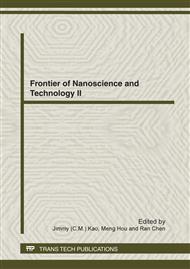p.219
p.223
p.229
p.233
p.237
p.241
p.245
p.249
p.254
Monte Carlo Simulation of Alpha (α) Particles Penetration in Nanoscale Silicon Semiconductor Materials
Abstract:
Microsystems, both in space and ground level, will use systems with III-V semiconductors and devices of nanoscale. Vulnerability of this system towards the radiations warrants extra care to be taken. Therefore, appropriate test and analysis to assure the hardness (radiation resistance) of components to be used in various radiation environments is necessary. In this paper, the defect generated in the interaction of alpha (α) particles and silicon (Si) semiconductor material is simulated using SRIM (Stopping and Range of Ions in Matter). The induced defects are in the form of vacancies, defect clusters and dislocations. Besides, the defect is found influencing the kinetic processes that occur both inside and outside the cascade volume. The radiation tolerance between the conventional scale and nanoscale thickness of silicon layer is also being compared. From the findings, it is observed that when the thickness of silicon layer is scaled down, defect that induced by the energy deposition of -particles is significantly lesser. This means that nanoscale silicon layer features improved radiation robustness towards the deposition of energetic ions.
Info:
Periodical:
Pages:
237-240
Citation:
Online since:
June 2012
Authors:
Keywords:
Price:
Сopyright:
© 2012 Trans Tech Publications Ltd. All Rights Reserved
Share:
Citation:


